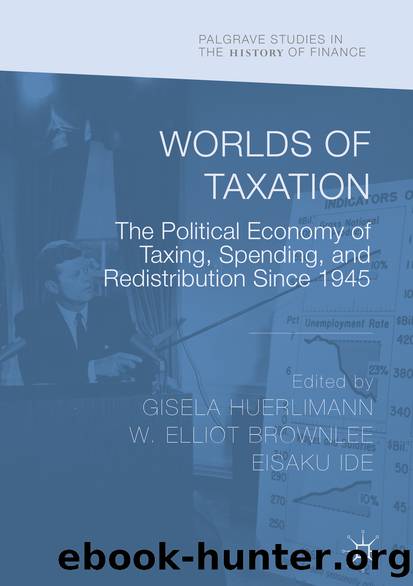Worlds of Taxation by Unknown

Author:Unknown
Language: eng
Format: epub
ISBN: 9783319902630
Publisher: Springer International Publishing
Effects of the Reagan Tax Cuts on Inequality
The across-the-board reduction of income tax rates and the investment-favoring tax expenditures in ERTA may not have marked a revolution in tax policy from the standpoint of revenue reduction or increases in tax expenditures, but the legislationâs cuts in the highest marginal rate, combined with the additional cut in that rate by the Tax Reform Act of 1986, may have had a major impact on the distribution of income and wealth. The cut in 1981 was from 77% to 50%âa cut of 27 percentage points that reduced the top rate by 35%. The cut in 1986 was even largerâfrom 50% to 28%, a cut of 22 percentage points that reduced the top rate by 44%. Both of these were the largest of either of the two earlier postâWorld War II cuts in the top rate. The two other cuts came in 1964âa cut from 91% to 77%, a cut of 14 percentage points that reduced the top rate by 14%, and in 1946âa cut from 94% to 86.45%, a cut of 7.55 percentage points that reduced the top rate by 8%. The Reagan cuts were more on the scale of the large cuts engineered by Andrew Mellon during the early 1920s. These cuts, in 1922 and 1923, reduced the top rate from 74% to 43.5%. The reduction by 29.5 percentage points reduced the top rate by 40%. This reduction was hugeâbut not as large as the overall cut of about two-thirds in the top rate in 1981 and 1986. Certainly, if all else had been equal, the reductions in the top rate in 1981 and 1986 would have increased the overall level of inequality substantially, just as did the cuts of the early 1920s. But other things were not equal.
Other elements in the tax legislation during the Reagan administration actually had offsetting effects, in the direction of reduced inequality. The lower rates reduced the value for the wealthy of the tax preferences than remained in the tax code after 1986, and they may have increased voluntary compliance with the tax code. More important, the loophole closing in 1982 through 1986, along with the expansion of the Earned Income Tax Credit (part of the 1986 legislation that provided major tax benefits for the working poor) and a set of increases in personal exemptions and standard deductions in 1986 (taking 6 million taxpayers off the rolls), had distinctly progressive effects. These provisions represented the success of a kind of rearguard action by Congressional Democrats, joined by some members of the Reagan administration, against the declining progressivity of the income taxation. As a consequence, the net effect of the tax policies of the Reagan administration was to leave the overall progressivity of the income tax essentially unchanged between 1981 and 1989. During the next decade, the tax increases of the administrations of George H.W. Bush and Bill Clinton moved that rate in a progressive direction.38
While the overall rate of progressivity did not change across the 1980s, the rate of taxing the top 1% of taxpayers did decline significantly.
Download
This site does not store any files on its server. We only index and link to content provided by other sites. Please contact the content providers to delete copyright contents if any and email us, we'll remove relevant links or contents immediately.
Harry Potter and the Goblet Of Fire by J.K. Rowling(3036)
Never by Ken Follett(2877)
Shadow of Night by Deborah Harkness(2716)
Ogilvy on Advertising by David Ogilvy(2680)
Zero to IPO: Over $1 Trillion of Actionable Advice from the World's Most Successful Entrepreneurs by Frederic Kerrest(2387)
The Man Who Died Twice by Richard Osman(2293)
Machine Learning at Scale with H2O by Gregory Keys | David Whiting(2278)
Book of Life by Deborah Harkness(2263)
How Proust Can Change Your Life by Alain De Botton(2259)
My Brilliant Friend by Elena Ferrante(2221)
0041152001443424520 .pdf by Unknown(2218)
The Tipping Point by Malcolm Gladwell(2204)
How to Pay Zero Taxes, 2018 by Jeff A. Schnepper(2098)
Will by Will Smith(2039)
Purple Hibiscus by Chimamanda Ngozi Adichie(1980)
Hooked: A Dark, Contemporary Romance (Never After Series) by Emily McIntire(1944)
Borders by unknow(1785)
Rationality by Steven Pinker(1763)
Daughter of Smoke and Bone by Laini Taylor(1742)
